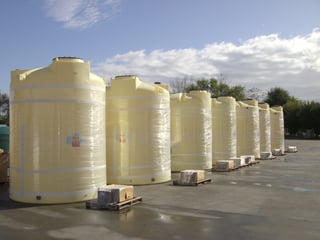How Rotational Molding Tank Manufacturers Differ
From truck beds to children’s toys, rotational molding is an efficient manufacturing process that’s used to produce a wide array of products. Rotational molding is especially effective in manufacturing storage tanks, and it’s the method Poly Processing uses to manufacture the most durable chemical tanks in the industry.
Rotational molding involves a heated hollow mold, which is filled with a plastic material. It is then slowly rotated (usually around two perpendicular axes), causing the material to disperse and adhere to the walls of the mold. The mold is continuously rotated during both the heating and cooling phases to ensure an even thickness and prevent deformation.
Rotational Molded Tanks
In the world of polyethylene rotational molding, many manufacturers are making something other than industrial and municipal chemical storage tanks.

Several companies use rotomolding to produce agricultural and water tanks, but very few companies specialize in chemical tanks. Chemical tanks require thicker walls and durable resins to withstand harsher applications. This is where Poly Processing sets the industry standard.
Agricultural and water storage tanks are manufactured with a linear polyethylene resin, which is more affordable and meets the minimum storage demands for those applications. Many smaller chemical tanks are rotomolded with linear polyethylene as well, but a linear resin is not capable of withstanding the power of harsh chemicals for long periods of time.
How Does Poly Processing Differ?
Poly Processing’s chemical storage tanks are manufactured with high-density cross-linked polyethylene (XLPE) instead of linear polyethylene. The polymer chains in XLPE connect in a muchstronger way than with linear polyethylene. Since cross-linked polyethylene is a thermoset material with stronger polymer connections, the life expectancy of XLPE tanks is longer than other tanks. This contrasts with standard polyethylene, which is a commodity material that is simpler to produce.
Poly Processing’s commitment to XLPE tanks is just one example of our investment in tank innovations. We have a history of using innovative materials and tank configurations, such as the OR-1000™, SAFE-Tank®, and IMFO®. We also partner with 3rd party researchers to stay on the forefront of chemical storage innovations.
We manufacture rotationally molded vessels in three locations located across the United States. Monroe, Louisiana. French Camp, California. Winchester, Virginia. The nine rotational molding machines can manufacture vessels from 30 gallons up to 13,650 gallons and tanks as large as 14 feet in diameter by 18 feet tall. Custom sizes and shapes to fit your unique storage requirements are available as well.
For more information on rotational molding or to discuss manufacturing a custom tank, please contact a chemical storage tank expert.
- August 3, 2017
- Topics: Tank Design and Materials
About Poly Processing
Posts By Topic
Tech Talk Podcast Episodes
Subscribe By Email
Recent Posts
- Maximizing Fill Efficiency: Selecting the Optimal Fill Line System
- Chemical Storage Tanks: A Quick Guide for End Users
- Popular Customization Options for Chemical Storage Tanks
- Understanding Flood Zones Under the IBC: Building Requirements and Insurance Implications
- Choosing Between Steel, Polyethylene, and Fiberglass Tanks: What You Need to Know
Tank Configurator

Find the recommended tank and system components for your chemical storage challenge.
Configure a Tank Package

.png?width=1024&name=Copy%20of%20Poly%20Blog%20Graphic%203%20(3).png)

